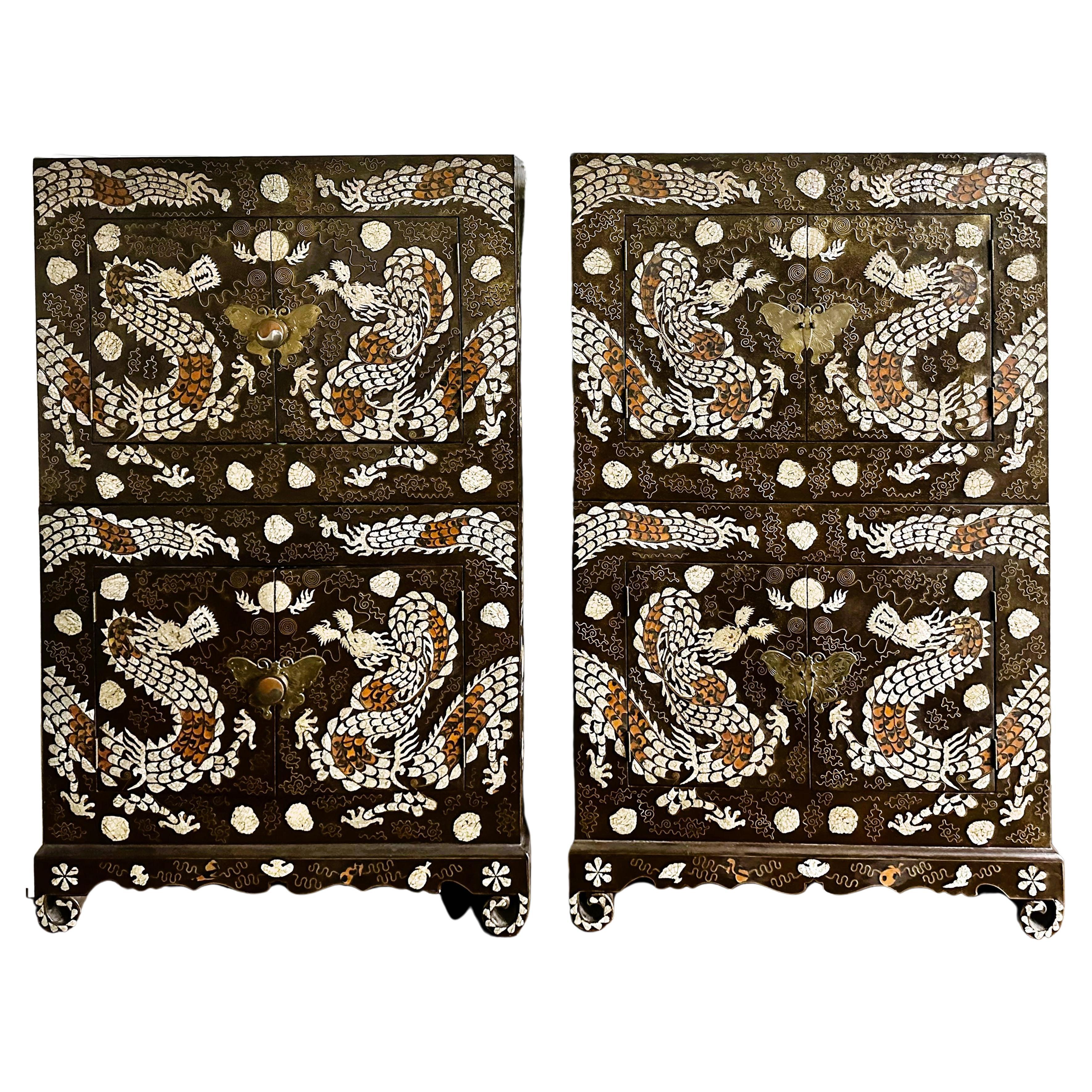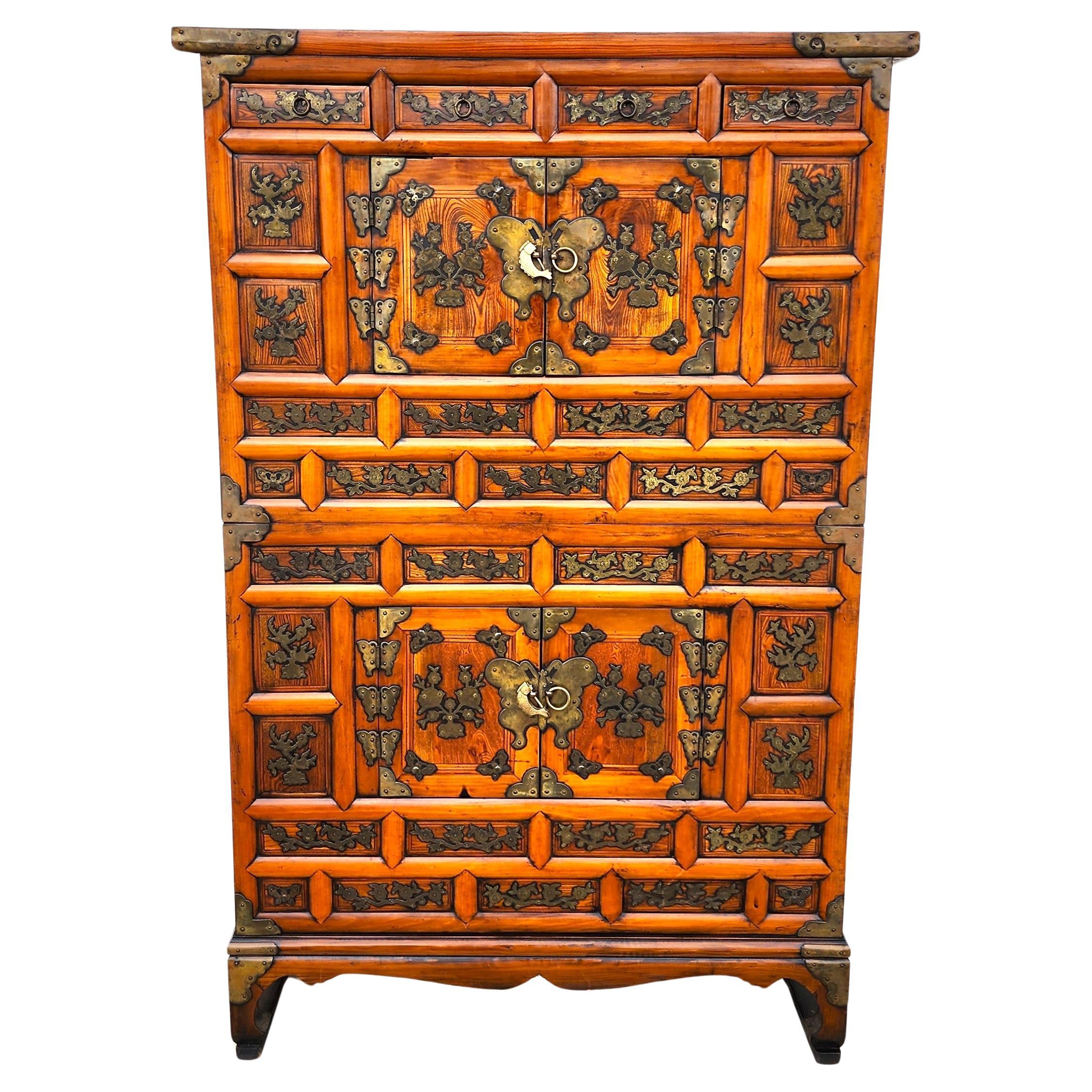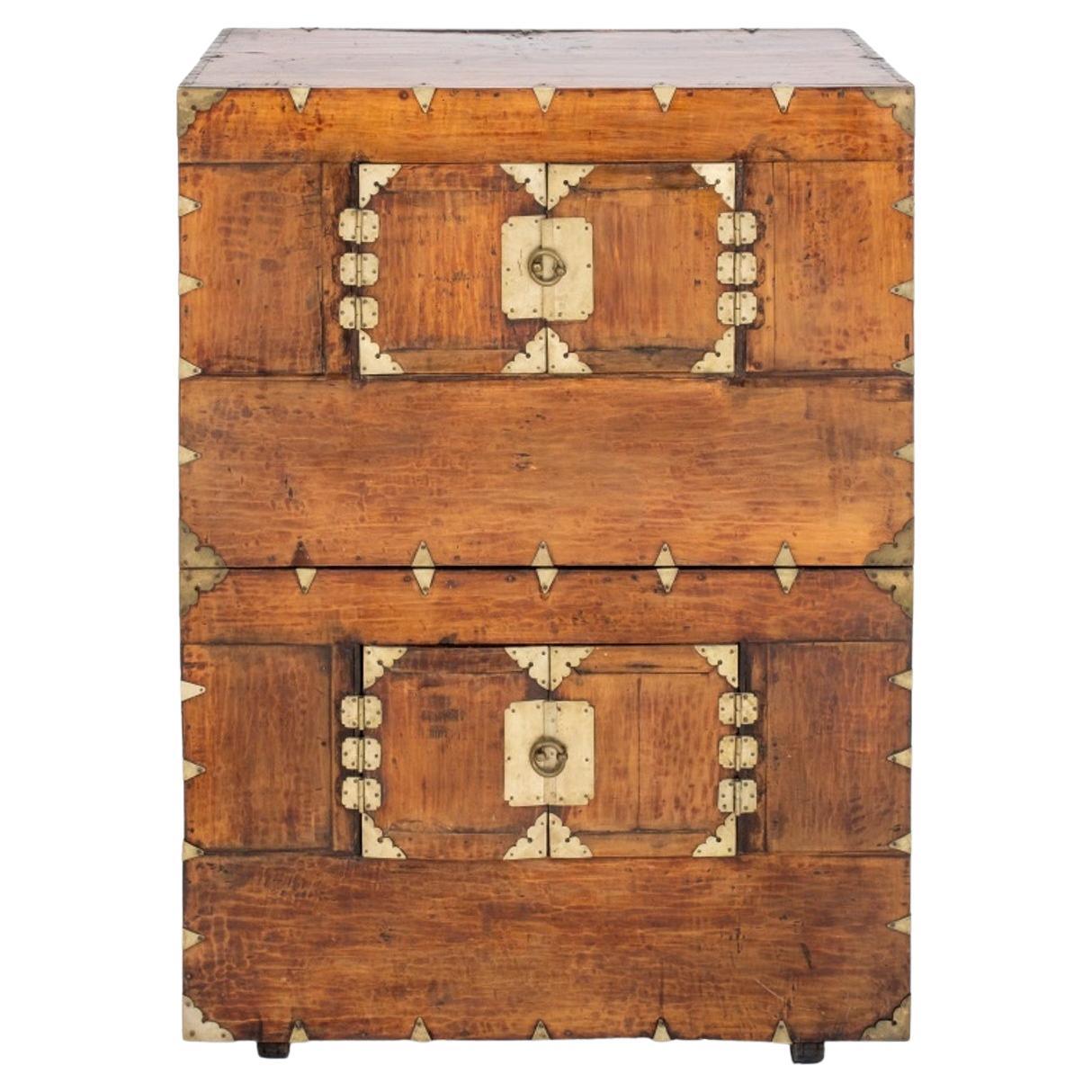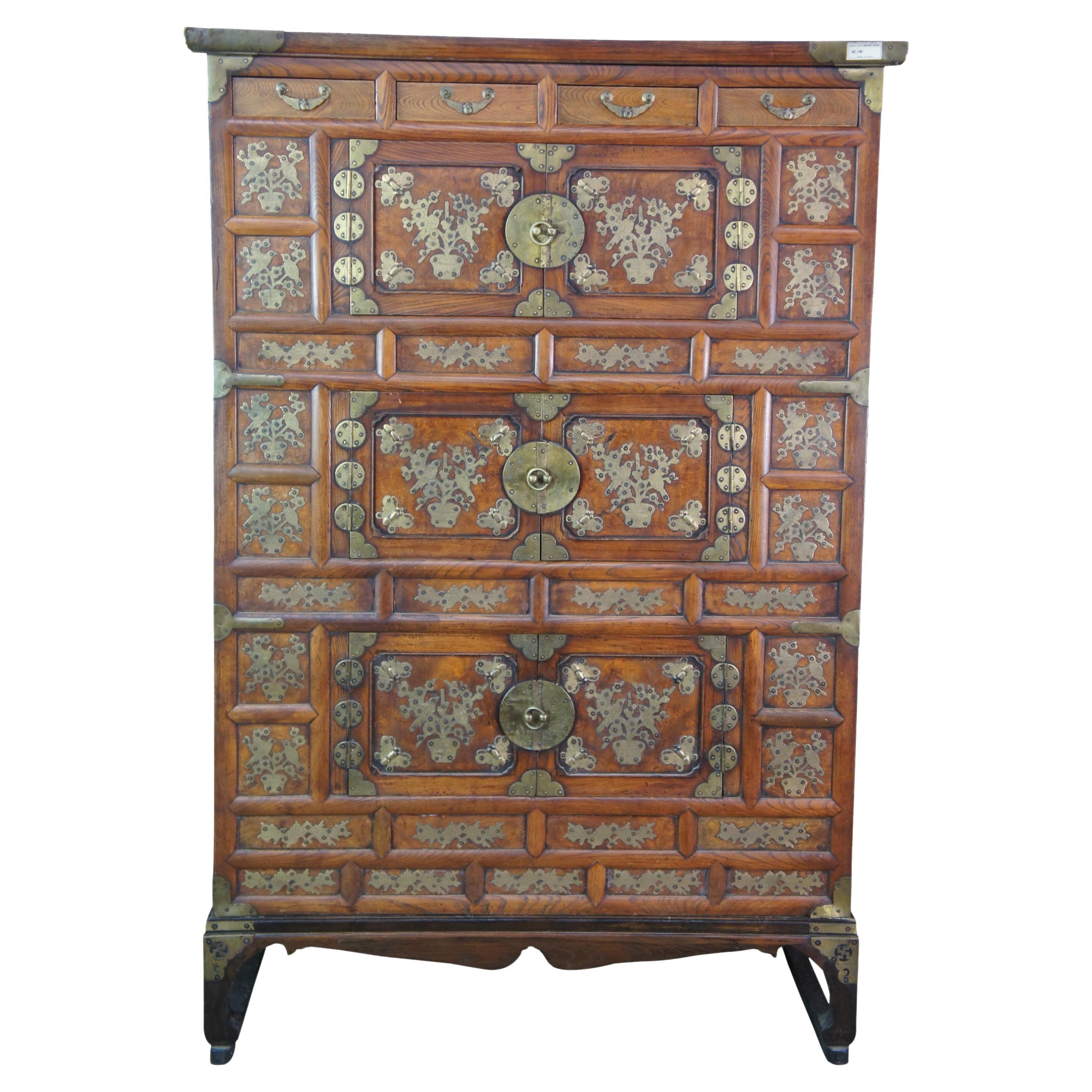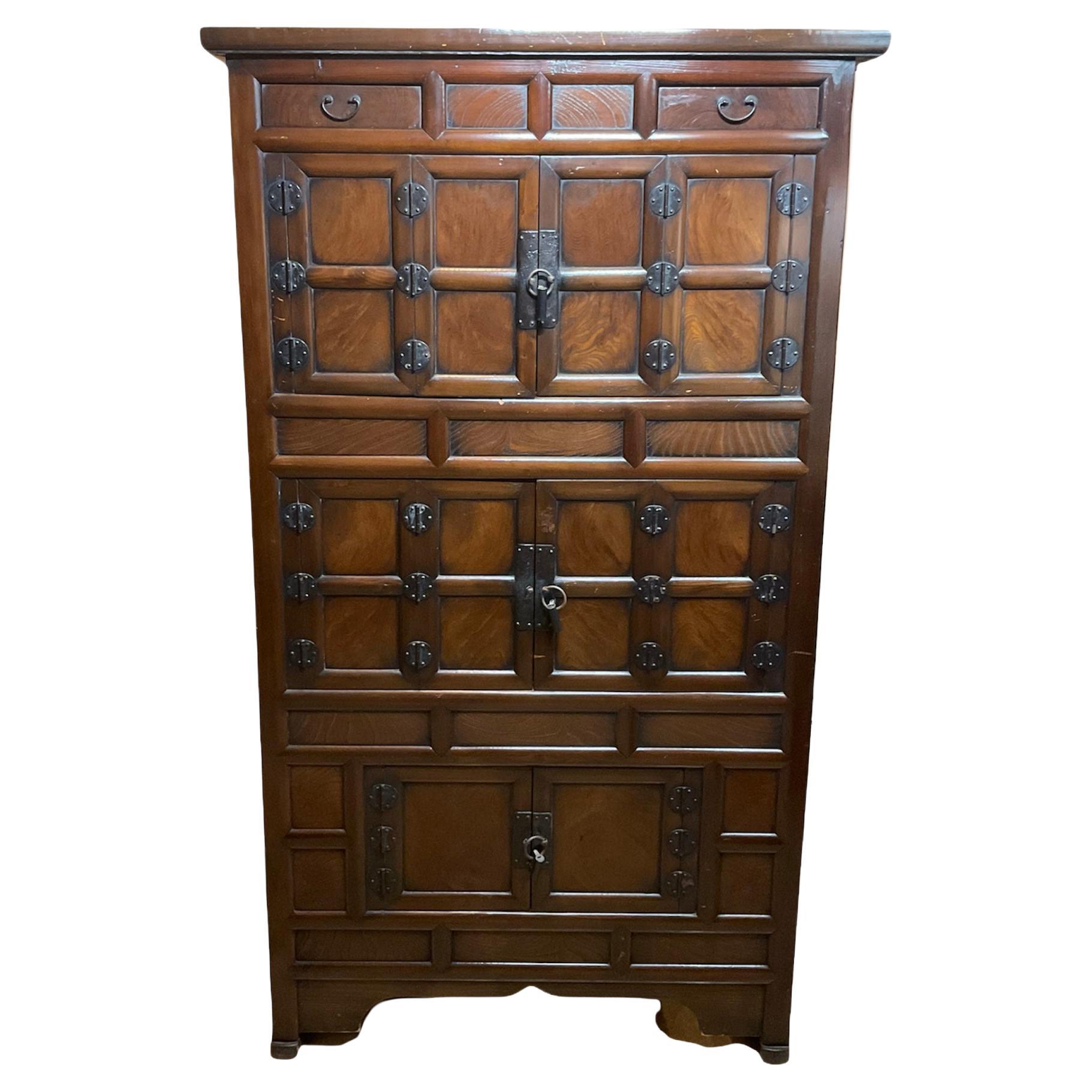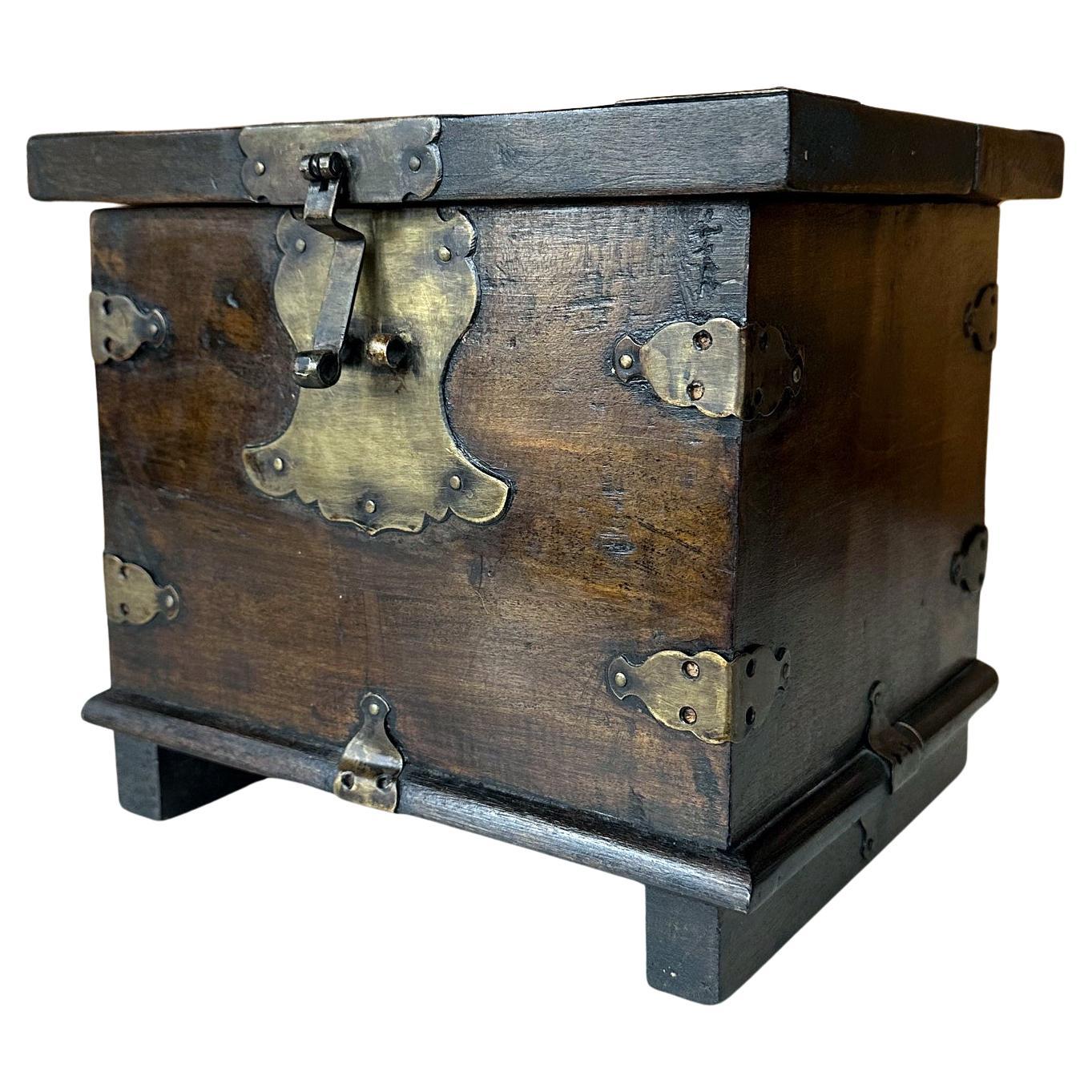Items Similar to Korean Antique Wood Stacking Nong Cabinets
Want more images or videos?
Request additional images or videos from the seller
1 of 21
Korean Antique Wood Stacking Nong Cabinets
About the Item
A two-tier stacking storage cabinet on comforting stand, known as Nong in Korean, circa early 20th century (end of Joseon to Korean Empire Period). Each cabinet is fitted with a pair of paneled doors opening in the center to ample storage. The upper cabinet also has a row of four small drawers on top. The stacking cabinet directly sit directly on top of the support stand. Constructed in pine frame with exposed finger joints, they were simply finished in black lacquer on top and the sides. The facade of the cabinets, however, showcases meticulously chosen persimmon wood panels. The striking wood veneer with the bold black grains were perfectly matched in mirrored fashion. Visually arresting, the dark wood grains appear like bold strokes on an abstract ink painting. The yellow brass hardware is of relatively smaller sizes with subdued motifs in order not to overtake the beauty of the wood. They consist of drawer pulls, corner brackets, petal-form hinges and larger lock plates with cutout coin design. The interior was stripped clean showing the natural wood and some residues of old lining rice paper.
We can trace the Nong cabinet on offer here to the more southern providences of the Korean Peninsula where Persimmon trees grow and were harvested, such as Jeolla Do or Chungcheong Do. The wood was beloved by Korean furniture makers in Yi dynasty and used on eye-catching pieces to emphasize the natural beauty of the wood. Examining the piece, one can see extensive and deep patina incurred from its age and previous use, yet the cabinet remains aesthetically stunning as an antique piece with an unexpected modern flare.
For a similar two-tier chest with near identical configuration, size and wood used, see relic no 007182 in the collection of National Folk Museum of Korea in Seoul. The piece is also illustrated on the cover as well as page 46 of the book "Korean Antique Furniture & Accessories" by Matthieu Deprez.
- Dimensions:Height: 46.25 in (117.48 cm)Width: 32.5 in (82.55 cm)Depth: 14.75 in (37.47 cm)
- Sold As:Set of 2
- Style:Other (Of the Period)
- Materials and Techniques:
- Place of Origin:
- Period:
- Date of Manufacture:1900-1910s
- Condition:Wear consistent with age and use. Minor losses. Well preserved with extensive patina throughout. Veneer crackle lines on the Persimmon panels, small scattered losses, along the seams and under one drawer. A lost wood knot hole on the side. Paper residues inside. Shrink lines on the backing plank.
- Seller Location:Atlanta, GA
- Reference Number:1stDibs: LU945038207312
About the Seller
5.0
Platinum Seller
These expertly vetted sellers are 1stDibs' most experienced sellers and are rated highest by our customers.
Established in 2006
1stDibs seller since 2010
479 sales on 1stDibs
Typical response time: <1 hour
- ShippingRetrieving quote...Ships From: Atlanta, GA
- Return PolicyA return for this item may be initiated within 2 days of delivery.
More From This SellerView All
- Pair of Korean Lacquer Wood Stacking Nong Cabinets with Striking InlaysLocated in Atlanta, GAA fine pair of two-tier stacking cabinets, known as Nong in Korean, circa early 20th century (Korean Empire to Japanese Colonial Period). The square cabinet each is fitted with a pai...Category
Early 20th Century Korean Other Furniture
MaterialsBrass
- Antique Korean Small Wood Box Joseon DynastyLocated in Atlanta, GAA small Korean antique box circa late 19th century of Joseon Dynasty. The square form box was constructed with thick hardwood planks on all side (appears to be elm) with a noticeable...Category
Antique 19th Century Korean Other Furniture
MaterialsBrass
- Antique Korean Lacquer Wood Soban Table Joseon PeriodLocated in Atlanta, GAA small antique wood table from Korea from turn of the 20th century (end of Joseon Dynasty). This type of light weight table is called "Soban" in Korean. which means "Small Tray". It was widely used primarily as individual dining table to present and serve foods, but also as small desk, incense burner...Category
Antique Late 19th Century Korean Other Furniture
MaterialsWood
- Antique Korean Lacquer Wood Soban Table Joseon PeriodLocated in Atlanta, GAAn antique wood table from Korea from late 19th century (end of Joseon Dynasty). This type of light weight table is called "Soban" in Korean. which means "Small Tray". It was widely used primarily as individual dining table to present and serve foods, but also as small desk, incense burner holder...Category
Antique Late 19th Century Korean Other Furniture
MaterialsWood
- Korean Headside Storage Cabinet Morijang Joseon DynastyLocated in Atlanta, GAA small Korean wood cabinet dated to the late Joseon Dynasty circa 19th century. The cabinet was known as "Morijang" in Korean and was traditionally used to keep valuables such as je...Category
Antique 19th Century Korean Other Furniture
MaterialsBrass
- Small Korean Cabinet with Drawers Gakkesuri Joseon DynastyLocated in Atlanta, GAA small Korean mixed wood cabinet dated to Joseon Dynasty circa 19th century. The cabinet was used to keep valuables such as jewelries and money, often placed on the bed functioning ...Category
Antique 19th Century Korean Other Furniture
MaterialsWood
You May Also Like
- Antique Korean Bandaji Nong Tansu Scholars Wedding CabinetLocated in Lake Worth, FLFor FULL item description click on CONTINUE READING at the bottom of this page. Offering One Of Our Recent Palm Beach Estate Fine Furniture Acquisitions Of An Antique Korean Elm & B...Category
Antique Early 19th Century Chinoiserie Furniture
MaterialsBrass
- Korean Stacking Yew Wood CabinetsLocated in New York, NYKorean Stacking yew wood cabinets, 19th / 20th bound in blackened metal each with cabinet doors opening for storage, the sides with handles. Dimensions: 40" H x 30.5" W x 13.5" D ...Category
Early 20th Century International Style Furniture
MaterialsMetal
- Antique Korean Elm Brass Bound Bandaji Nong Tansu Scholars Chest Wedding CabinetLocated in Dayton, OHFine & early 19th century Korean Tansu Nong Bandaji tallboy wedding chests or cabinet made of elmwood featuring ornate brass floral, butterfly, bird and sauwastika accents. The swastika symbol, ? (right-facing or clockwise) or ? (left-facing, counterclockwise, or sauwastika), is an ancient religious icon in the cultures of Eurasia. It is used as a symbol of divinity and spirituality in Indian religions, including Hinduism, Buddhism and Jainism. Acquired from Moby Dicks Maritime Antiques in the 1970s. Antique Korean Bandaji chest...Category
Antique Early 19th Century Chinoiserie Furniture
MaterialsBrass
- Korean Large Elm Wood Cabinet/ChestLocated in Guaynabo, PRThis is a Korean large wood cabinet/chest. The cabinet has two drawers at the top with C-shaped iron handles and below it, there are 3 compartments....Category
Early 20th Century Korean Han Furniture
MaterialsWood
- Antique Korean Tansu Butterfly Cabinet or Chest Elm Wood with Brass InlayLocated in Plainview, NYA stunning late 19th century Campaign Korean tansu cabinet or chest. The Korean chest features 4 small drawers on top of a two door cabinet offeri...Category
Antique 19th Century Korean Campaign Furniture
MaterialsBrass
- Antique Korean Blanket ChestLocated in Hudson, NYAntique Korean Blanket chest, elaborately decorated with ornate brass mounts in various geometric forms, some of which have incised landsc...Category
Early 20th Century Korean Furniture
MaterialsBrass
Recently Viewed
View AllMore Ways To Browse
Pair Of Small Cutout Cabinets
Pair Of Korean Cabinets
Asian Cabinet Antique
Black Lacquer Corner Cabinet
Japan Vintage Scroll
Asian Medicine Cabinet
Dragon Design Wooden Panel
Chinese Lacquer Mark
Personality Chair
Modern Glass And Chrome Sconce
Italian Brass Decor
Lacquered Metal Floor Lamp
Woven Band Rug
Wired Sconces French
Marble Pattern Table
Wood Carved Dining Room Chairs
Japanese Lacquer Art
Mid Century Black And Beige Art
